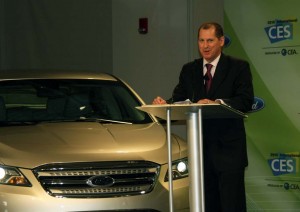
“Sales of in-vehicle technologies are expected to top $9.3 billion this year,” says Gary Shapiro, President of the Consumer Electronics Assn.
From cheap, aftermarket navigation systems, to the 2200-watt multimedia/audio system in the new Bentley Mulsanne, the car is becoming the mobile equivalent of office or living room, with in-vehicle technology sales pushing past $9 billion this year, despite the economic downturn, according to an industry trade group.
It’s probably no surprise, then, that senior auto industry officials have served as keynote speaker at the electronics industry’s top trade show, for the last four years. And Ford CEO Alan Mulally, who was keynoter at the 2009 Consumer Electronics Show, will return as opening speaker at the January 2010 CES.
“We’re seeing the convergence of the technology and auto industries,” noted Gary Shapiro, president and CEO of the Consumer Electronics Association, which operates CES, the biggest trade show held in Las Vegas, each year.

Ford CEO Alan Mulally was keynote speaker at the 2009 Consumer Electronics Show. He'll be back as the opening speaker in January 2010.
At least 2,000 new products are previewed by the 2,500-plus vendors who participate in the annual event, noted Shapiro, with a growing share of those vendors and goods aimed at the auto industry. That’s not surprising, considering “Sales of in-vehicle technologies are expected to top $9.3 billion this year,” noted Shapiro, adding that, “The car has become a mobile living room.”
Shapiro announced Mulally’s planned speech during an appearance at Ford’s test track, near its Dearborn, Michigan, headquarters. During his own comments, the CES president praised the automaker for “acting and thinking like an electronics company.”
That’s a high compliment for an automaker, part of a business where it can take three to five years to bring a new vehicle to market. That’s in sharp contrast to electronics hardware and software providers, where product cycles can run as short as six months.
Ford learned a painful lesson, a decade ago, when it tried to develop an emergency call system in-house. The technology failed and Ford abandoned the field until it signed on for a joint venture with Microsoft – which resulted in the creation of the SYNC system.
The underlying technology is closer to the computer world’s plug-and-play architecture; so, working with Microsoft and other partners, such as Sirius Satellite Radio, software can be easily upgraded, and new features readily added, much as with a personal computer. The latest version of Sync provides real-time traffic, for example, and will eventually permit motorists to track down the cheapest gas and local movie times, among other features.
“We want to deliver new features at 6 or 12-month intervals, when it might have been 24 or even 36 months” using the traditional automotive approach, said Jim Buczkowski, director of electrical and electronic engineering, at Ford.
The car has become as much an electronic device as a mechanical wonder, with digital technology controlling everything from the engine to the brakes to the infotainment system. The all-new Ford Taurus, for example, offers a new Cross-Traffic Alert system, which can spot oncoming cars as a motorist backs out of, say, a mall parking spot.
“Consumers are willing to open their wallets” for such technology, asserted Steve Koenig, an industry researcher for the CEA. But he acknowledged that in some cases, automakers have been surprisingly slow to bring costs in line with the competition. While Ford is charging $395 for the Sync system, it commands as much as $1,500 for an in-dash navigation system with LCD video screen. Yet aftermarket providers are now offering their own, portable navis for as little as $100, and typically under $600 for even the most advanced devices.
“We see where we have to be to compete with brought-in technology,” acknowledged Ford’s Buczkowski.
Indeed, manufacturers are being forced to not only compete with, but often to embrace outside providers. Several carmakers are now offering navi systems that can be removed from their vehicles and used on another automobile. And with rare exception, the auto industry has all but abandoned the idea of building cellphone systems into their vehicles. Instead, they’re using hardwired or Bluetooth links to connect with hand-held phones like a Blackberry or iPhone.
The growth of mobile consumer electronics does face some large hurdles. A growing number of states and communities have banned the use of hand-held cellphones, and similar bans are likely for driving while texting. Indeed, there are those who would ban the use of hands-free cellphones, though CEA President Shapiro scoffed at the idea, suggesting that a heated debate between husband and wife can prove more risky.
Critics no doubt will note his callous and self-interested position in what is a growing and deadly problem that the Department of Transportation will hold hearings on later this month.
For automakers, the growth in in-car technology has a number of potential advantages. The technology itself can generate substantial revenues. And it can prove a competitive advantage, as well, must as leather seats or high-performance engines long have been. Buczkowski noted that on vehicles where Sync is available, 70% of buyers are opting for the technology.
But this convergence is also critical for the electronics world, added Shapiro. With the value of in-car technology steadily rising, “It’s incredibly important for the consumer electronics industry” to keep the momentum going.

